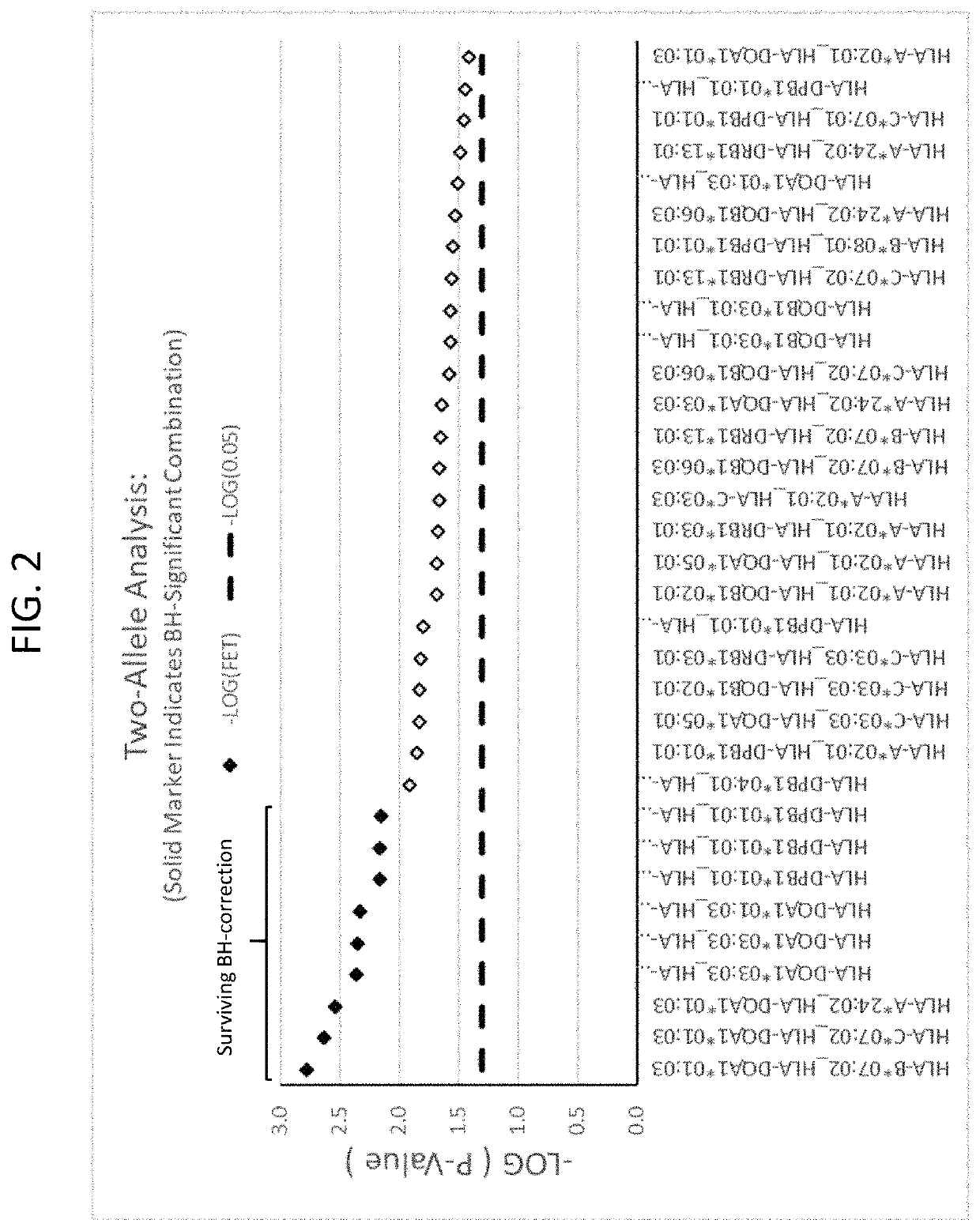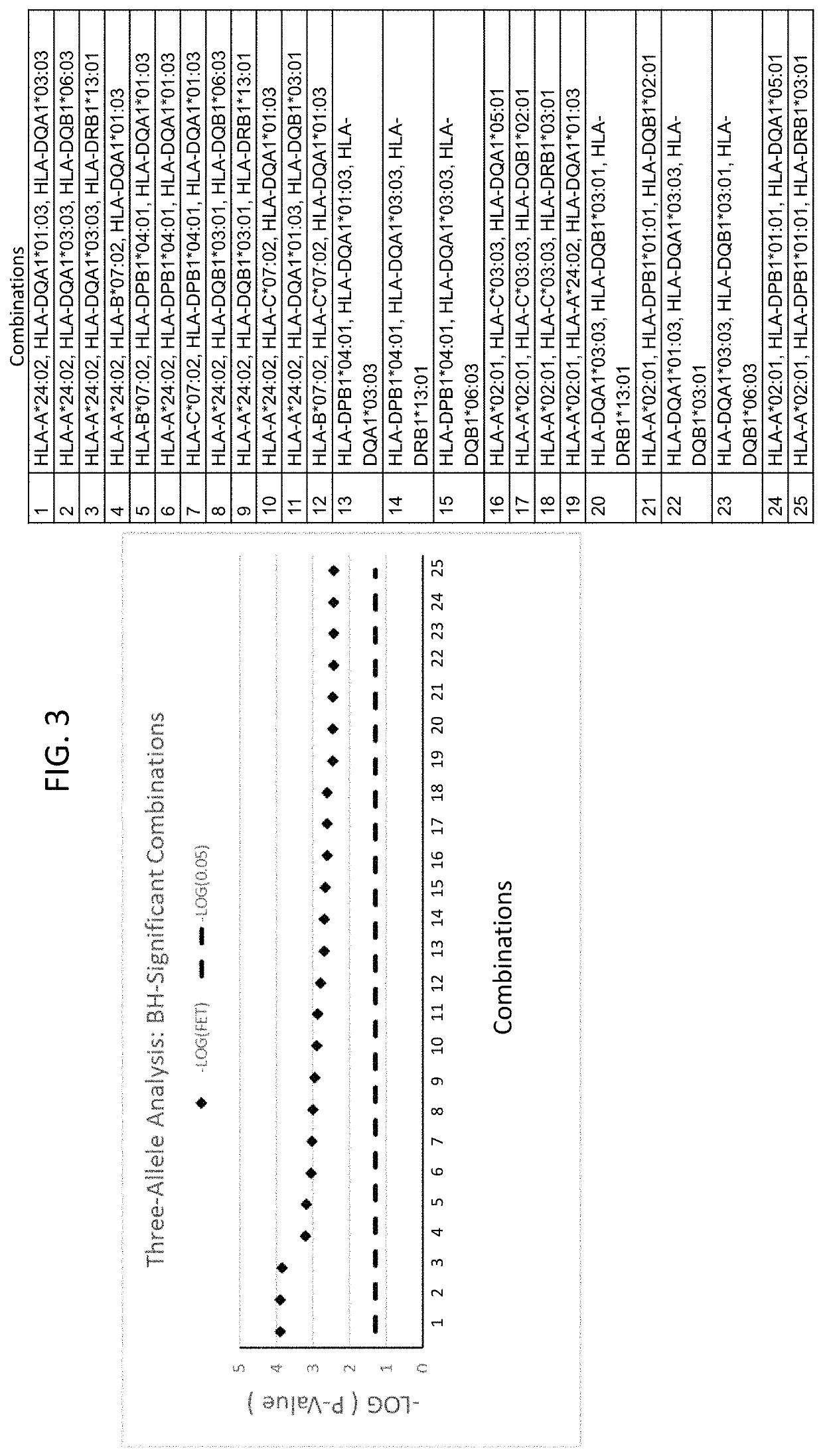Methods for reducing drug-induced liver injury
a liver injury and drug technology, applied in the field of drug-induced liver injury reduction, can solve the problems of acute liver failure, avoiding long-term or permanent liver damage, and dili not being detected, so as to reduce the risk of drug-induced liver injury, reduce the risk of dili development, and reduce the risk of liver damag
- Summary
- Abstract
- Description
- Claims
- Application Information
AI Technical Summary
Benefits of technology
Problems solved by technology
Method used
Image
Examples
example 1
sis of Patients with ADR Following Exposure to Infliximab
[0195]A set of 12 samples from subjects that had been treated with infliximab and had experienced drug-induced liver injury (DILI) (hereinafter referred to as “diseased samples”) were HLA tested and compared to a set of 10,397 healthy control samples (hereinafter referred to as “healthy samples”). The healthy samples were obtained from a general population of human subjects who did not experience DILI, and who may or may not have been exposed to infliximab. Analysis of a patient's genomic HLA profile and a robust statistical analysis was performed to identify HLA alleles and / or sets of alleles that are risk factors for the development of DILI following infliximab exposure.
[0196]In the first analysis of the infliximab samples, the inventors sought to find if the proportion of diseased samples exposed to an allele varied significantly from the proportion of the healthy samples with that allele. In order to do so, for each allele...
example 2
LA Analysis of Patients with ADR Following Exposure to Infliximab
[0210]A set of 25 additional samples from subjects that had been treated with infliximab and had experienced DILI were obtained. These are referred to as “cases” here. These samples were compared to a set of 60 matched controls. The matched controls were patients who received infliximab for at least one year and did not experience DILI. The controls were matched for age, sex, ethnicity, and BMI where possible. Statistical analyses were performed to identify from these cases HLA alleles that are risk factors for the development of DILI following infliximab exposure. Significant alleles were determined using Fischer's Exact Test (FET) (p<0.05).
[0211]As a secondary comparison, the HLA profiles of the 25 cases were compared to reference populations available at www.allelefrequencies.net. For calculating population presence rates, reference list entries were found by searching for “Caucasoid” ethnic origin subjects of gold-...
example 3
on HLA Analysis of Patients with DILI Following Exposure to Infliximab
[0221]A set of 22 additional samples from subjects that had been treated with infliximab and had experienced DILI were obtained from a population of patients in Iceland. These are referred to as “cases” in the “Replication” cohort here. Using the same 60 controls from Example 2 (“Controls”) as a reference population, statistical analyses were performed to identify which of the HLA alleles found to confer risk for the development of DILI following infliximab exposure in Example 2 were also found to achieve significance among the “Replication” samples. Significance was determined using Fisher's Exact Test (FET) (p<0.05). Additionally, the 16 Caucasian DILI patients from the “Discovery” samples (in Example 2) and 22 Icelandic “Replication” samples were combined into a single “Combined Cases” cohort of 38 infliximab-DILI cases and used to re-challenge these alleles for significance against the 60 Controls using Fisher...
PUM
| Property | Measurement | Unit |
|---|---|---|
| body weight | aaaaa | aaaaa |
| frequency | aaaaa | aaaaa |
| time | aaaaa | aaaaa |
Abstract
Description
Claims
Application Information
 Login to View More
Login to View More - R&D
- Intellectual Property
- Life Sciences
- Materials
- Tech Scout
- Unparalleled Data Quality
- Higher Quality Content
- 60% Fewer Hallucinations
Browse by: Latest US Patents, China's latest patents, Technical Efficacy Thesaurus, Application Domain, Technology Topic, Popular Technical Reports.
© 2025 PatSnap. All rights reserved.Legal|Privacy policy|Modern Slavery Act Transparency Statement|Sitemap|About US| Contact US: help@patsnap.com



